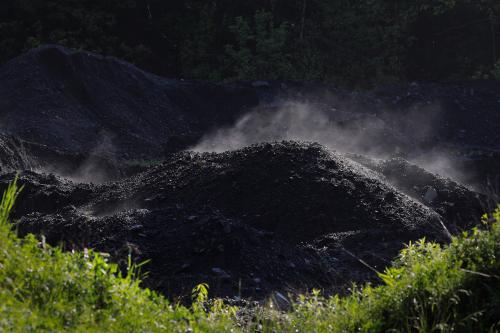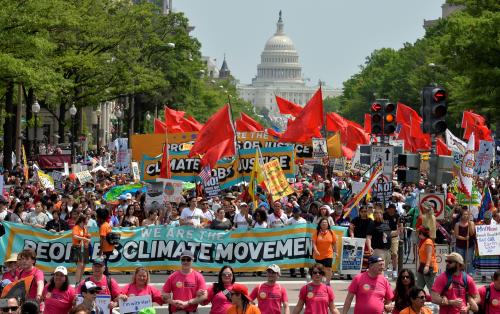The Vitals
The president and his administration exercise substantial influence on the environment through regulation and executive authority. President Donald Trump took office promising a business-friendly, deregulatory agenda. Shortly after taking office, he issued an executive order that for every new regulation put in place, two had to be eliminated. His deregulatory agenda extends into the rules that protect our nation’s air and water and address climate change. Brookings is tracking the administration’s deregulatory actions, and counts 74 actions that the administration has taken to weaken environmental protection.
Presumptive Democratic presidential nominee Joe Biden proposes a different course for environmental protection, with addressing climate change as a central part of his platform. He has established an ambitious goal of net-zero greenhouse gas emissions by 2050. Achieving this goal would require reversing the current course of rolling back regulation, along with new legislation.
-
Brookings counts 74 actions to date by the Trump administration to weaken environmental protection.
-
President Trump is particularly focused on rolling back policy to address climate change, which is possible because Congress has been unwilling to enshrine such policy in law.
-
In addition to deregulatory actions to support the fossil fuel industry, our nation’s core environmental laws that ensure clean air and water and protect sensitive lands are also a focus of regulatory rollbacks.
A Closer Look
The following is not a complete listing of the administration’s deregulatory efforts, but rather is a sampling of the most impactful efforts and the areas where deregulation is most concentrated.
Climate regulations are a frequent target
The Trump administration has been particularly focused on rolling back actions intended to deal with climate change. On June 1, 2017, President Trump promised to withdraw from the Paris Agreement, an agreement among 195 nations to cut their greenhouse gas (GHG) emissions to avoid the worst impacts of climate change. The United States stands alone among major emitters in the world in its efforts to repudiate the agreement and cannot officially withdraw until the day after the 2020 election in November.
President Trump’s ability to roll back climate rules stems from actions of the Obama administration, which used existing law and executive orders to regulate GHG emissions because Congress was unwilling to act. In 2007, the U.S. Supreme Court found that greenhouse gases are within the Clean Air Act’s definition of an air pollutant, and thus can be regulated as such. President Barack Obama used the Clean Air Act to establish the Clean Power Plan, a cornerstone of that administration’s strategy to reduce GHG emissions. The plan— under legal challenge from the beginning— was designed to reduce carbon dioxide (CO2) emissions from the power sector and had the effect of prohibiting new coal plants without carbon capture and storage. It allowed a comprehensive approach to compliance, including demand management and other strategies outside the fence line of power plants; opponents claimed that the Obama administration did not have the authority to regulate in this way.
The Trump administration replaced the Clean Power Plan with a weaker regulation and is in the process of eliminating other regulations that limit GHG emissions. Since CO2 is considered a pollutant under the Clean Air Act, the Trump administration had to provide a replacement for the Clean Power Plan. The Affordable Clean Energy Rule in place today, according to the Environmental Protection Agency, will only result in a 1% reduction in GHG emissions from power plants, compared to no policy at all. Fuel economy standards for cars and light trucks have also taken a hit; transportation is the largest source of U.S. GHG emissions. For model years 2021 through 2026, fuel economy must increase by 1.5% a year, a change from the previous rule that mandated improvements of 5% per year. The change also took away California’s ability to set its own fuel economy rules, an ability it has had since the Clean Air Act was enacted in 1970. Finally, the Trump administration has weakened rules limiting venting or flaring of methane from oil and gas production on public lands and requiring reporting of methane emissions from most oil and gas production. Methane is a greenhouse gas more potent than CO2, although it has a shorter lifespan in the environment.
Regulatory rollbacks are intended to boost fossil fuel production and use
The Trump administration has frequently targeted regulations governing the production and use of fossil fuels. For example, the administration rolled back regulations on airborne emissions of mercury, a potent neurotoxin, and other toxic substances from power plants and reduced regulation of the disposal and storage of coal ash, a residue from coal combustion that contains mercury, arsenic, and other toxins that has caused water pollution during releases. Both changes were part of President Trump’s effort to fulfill his campaign promise to revive the U.S. coal industry. However, coal used in power generation in 2019 was down 22% from 2016, the year before President Trump took office. Coal’s decline is due to fierce competition from inexpensive natural gas, not regulation.
Regulations that govern fossil fuel production on public lands have been another frequent target for deregulation. President Trump has lifted bans on oil and gas exploration in the Arctic National Wildlife Refuge and parts of the National Petroleum Reserve in Alaska, in coastal waters around the United States, and in areas formerly protected as National Monuments in Utah.
The administration has also intervened in permitting for fossil fuel infrastructure. Best known among these projects is the Keystone XL pipeline, intended to bring oil sands crude oil from Canada. But the administration also intervened in the approval for the Dakota Access pipeline to move oil from North Dakota’s oil fields and in some permits for the Atlantic Coast pipeline, intended to transport natural gas from the Marcellus Shale in West Virginia.
Air, water, and land protection laws are not left out
In addition to deregulatory actions that support the fossil fuel industry, our nation’s core environmental laws that ensure clean air and water and protect sensitive lands are also a focus of the administration’s regulatory rollbacks. Some of these decisions have important consequences for human health, among them the refusal to strengthen National Ambient Air Quality Standards (NAAQS) for fine particulate matter and ozone. NAAQS are a cornerstone of U.S. policy to reduce air pollution and must be reviewed by an independent science advisory committee every five years. The Clean Air Act allows consideration of human health and welfare, not cost of compliance, as these standards are reviewed. However, the administration worked to change the composition of the advisory committees to include more industry and anti-regulatory members, limit the scientific research that the committees could consider, and accelerate the process to limit the scope of the review. Another decision that affects human health is keeping the pesticide chlorpyrifos on the market, despite evidence of its risks.
Other decisions limit government’s protection of sensitive lands. Key among them is the administration’s push to update the National Environmental Quality Act, passed in 1970 during the Nixon administration. Complying with this law can be time consuming; from 2010 through 2017, projects that required an Environmental Impact Statement took an average of 4.5 years to move through the process. The new rule intends to limit environmental reviews of projects to two years, limit the role of climate change in environmental assessments, and exclude some projects from the environmental assessment requirement. The administration is also limiting water bodies subject to the Clean Water Act to exclude some wetlands and intermittent streams that flow into larger bodies of water.
The administration faces legal challenges in achieving its deregulatory goals
The administration’s rollbacks of environmental (and other) regulations have faced ongoing legal challenges. Changes in regulation cannot be challenged in court until they are finalized, but every one of the deregulatory actions described above that has reached that point is being challenged in the courts. This is not unusual; environmental regulations are often contentious and require making decisions under uncertainty, conditions that make them ripe for challenge. Plaintiffs in these challenges include states, cities, and environmental and health organizations.
Nonetheless, the Trump administration has often cut corners, which has hurt it in court. Under the Administrative Procedures Act, federal agencies must notify the public, allow public comments, and justify their decisions to change regulation. The administration has sometimes skipped or shortened these steps to rescind or change rules more quickly, only to get sued.
In addition to lawsuits alleging violations of the Administrative Procedures Act, challenges are being filed on the basis that the regulations do not meet the government’s duty under specific laws, such as the Clean Air Act or Clean Water Act. The National Environmental Policy Act is another basis for challenges, if the revised regulation does not sufficiently consider the cumulative environmental effect of the change. To date, challenges to Trump’s deregulatory actions have been very successful. The Institute for Policy Integrity at the New York University School of Law found that the Trump administration has lost 87% of challenges to its regulations, guidance documents, and agency memoranda.
Not every regulatory change has been defeated or can even be challenged. The COVID-19 crisis has opened a new pathway for deregulatory action. For example, the Environmental Protection Agency announced on March 26, 2020, that it would suspend enforcement of environmental regulations on companies that are unable to comply owing to the COVID-19 pandemic. This provision will expire on August 31, 2020. President Trump also issued an executive order to scale back review of infrastructure projects under the National Environmental Policy Act, Clean Water Act, and Endangered Species Act. The intent is to expedite infrastructure investments to facilitate the economic recovery from the COVID-19 crisis.
As I write this piece, the administration continues to suffer legal defeats. On July 6, 2020, the U.S. District Court for the District of Columbia ordered the already completed Dakota Access pipeline to halt operations, because the Army Corps of Engineers did not adequately consider impacts to the Standing Rock Sioux tribe in its environmental assessment. An appellate court has granted a temporary stay, allowing the pipeline to continue operating for now, but its future is uncertain. On July 15, 2020, a federal court in California vacated the rollback of methane emissions regulations on public lands, saying that the government, “engineered a process to ensure a preordained conclusion.” Litigation on other regulatory changes continues, but the administration’s track record in court is not good.
Potential Biden administration promises very different priorities
Presumptive Democratic nominee Joe Biden has offered very different plans for environment and climate policy. Climate is a key part of his platform, with an overall goal of net-zero U.S. GHG emissions by 2050. Parts of the Biden agenda involve reinstating and, in some cases, strengthening regulations that the Trump administration is working to remove, including limiting methane emissions, strengthening fuel economy standards, and prohibiting fossil fuel development on public lands. Biden has also promised to immediately re-join the Paris Agreement if he is elected.
Other parts of the Biden plan cannot be implemented under existing laws, and thus would require action from Congress. Key among his legislative proposals is an enforcement mechanism to ensure the economy reaches the mid-century decarbonization goal and that polluters bear the full cost of their carbon emissions. Other priorities include investing in clean energy and low-carbon innovation, encouraging the adoption of electric vehicles, and advancing low-carbon manufacturing. All these actions and more are needed to reach the overall decarbonization goal, but they depend on a Congress amenable to such actions.







Commentary
What is the Trump administration’s track record on the environment?
August 4, 2020